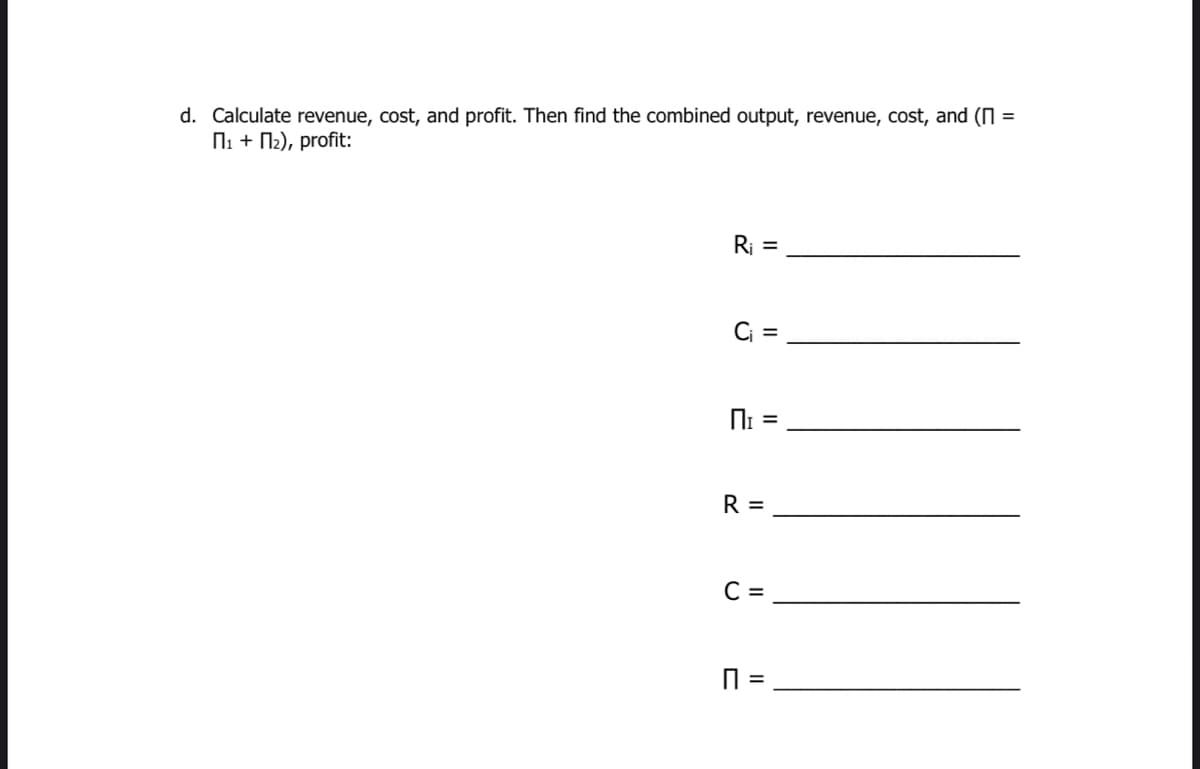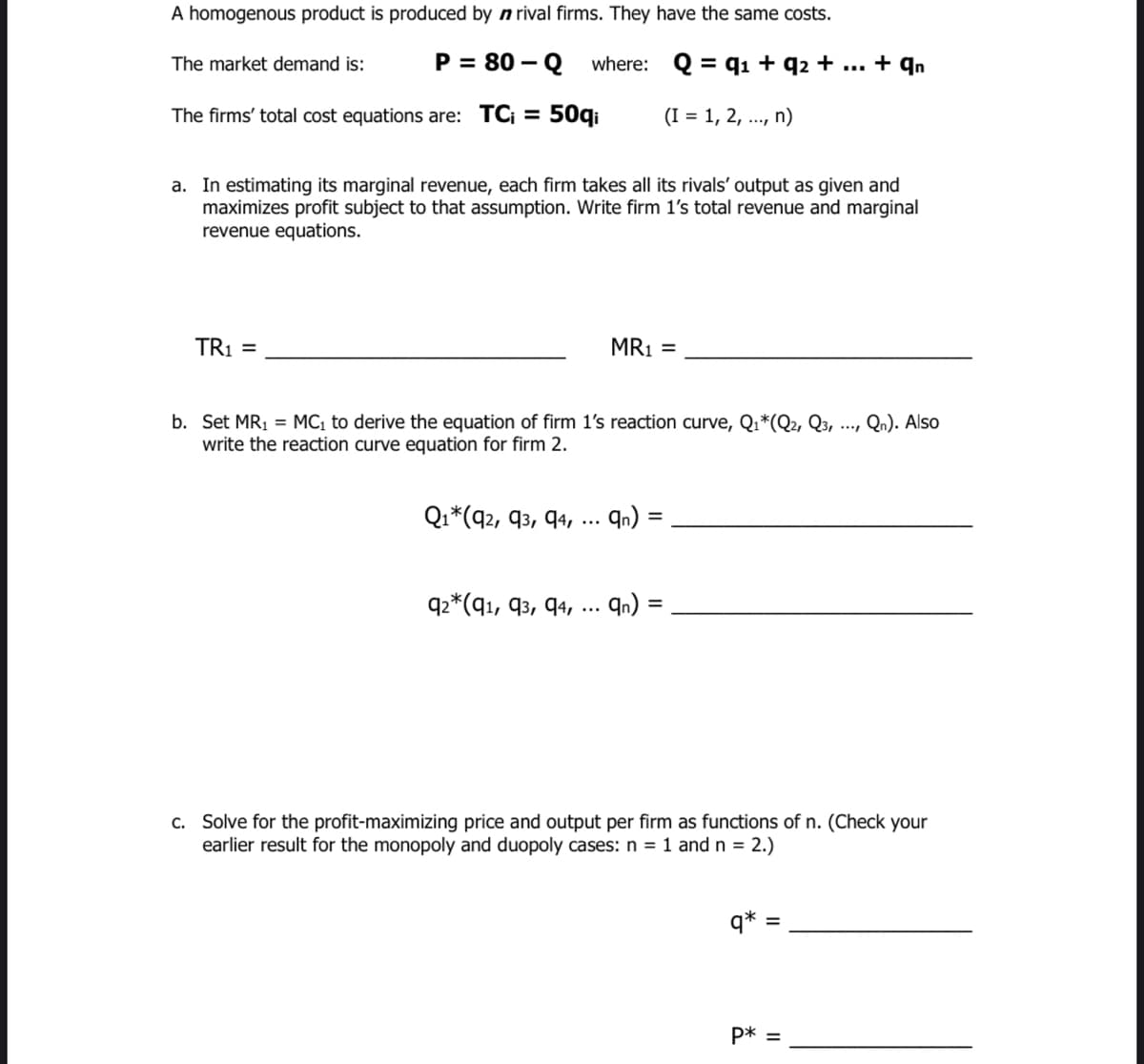A homogenous product is produced by n rival firms. They have the same costs. The market demand is: P = 80 – Q where: Q = q1 + q2 + ... + qn %3D - The firms' total cost equations are: TC; = 50qi (I = 1, 2, .., n) a. In estimating its marginal revenue, each firm takes all its rivals' output as given and maximizes profit subject to that assumption. Write firm 1's total revenue and marginal revenue equations. TR1 = MR1 = b. Set MR1 = MC; to derive the equation of firm l's reaction curve, Q:*(Q2, Q3, write the reaction curve equation for firm 2. Qn). Also Qi*(q2, q3, 94, - qn) = ... q2*(qı, q3, q4, . qn) = %3D ... c. Solve for the profit-maximizing price and output per firm as functions of n. (Check your earlier result for the monopoly and duopoly cases: n = 1 and n = 2.) q* : %3D P* =
A homogenous product is produced by n rival firms. They have the same costs. The market demand is: P = 80 – Q where: Q = q1 + q2 + ... + qn %3D - The firms' total cost equations are: TC; = 50qi (I = 1, 2, .., n) a. In estimating its marginal revenue, each firm takes all its rivals' output as given and maximizes profit subject to that assumption. Write firm 1's total revenue and marginal revenue equations. TR1 = MR1 = b. Set MR1 = MC; to derive the equation of firm l's reaction curve, Q:*(Q2, Q3, write the reaction curve equation for firm 2. Qn). Also Qi*(q2, q3, 94, - qn) = ... q2*(qı, q3, q4, . qn) = %3D ... c. Solve for the profit-maximizing price and output per firm as functions of n. (Check your earlier result for the monopoly and duopoly cases: n = 1 and n = 2.) q* : %3D P* =
Managerial Economics: Applications, Strategies and Tactics (MindTap Course List)
14th Edition
ISBN:9781305506381
Author:James R. McGuigan, R. Charles Moyer, Frederick H.deB. Harris
Publisher:James R. McGuigan, R. Charles Moyer, Frederick H.deB. Harris
Chapter12: Price And Output Determination: Oligopoly
Section: Chapter Questions
Problem 3E
Related questions
Question
Finding a solution to this problem is hard because I’m not exactly sure how to generalize the cournot model. Could I have help please.

Transcribed Image Text:d. Calculate revenue, cost, and profit. Then find the combined output, revenue, cost, and (N =
Пі + П), profit:
Ri
%3D
C =
П
R =
C =

Transcribed Image Text:A homogenous product is produced by n rival firms. They have the same costs.
The market demand is:
P = 80 – Q
where: Q = qi + q2 + ... + qn
The firms' total cost equations are: TCj = 50qi
(I = 1, 2, ..., n)
a. In estimating its marginal revenue, each firm takes all its rivals' output as given and
maximizes profit subject to that assumption. Write firm 1's total revenue and marginal
revenue equations.
TR1 =
MR1 =
b. Set MR1 = MC; to derive the equation of firm 1's reaction curve, Q1*(Q2, Q3, ...,
write the reaction curve equation for firm 2.
Qn). Also
Q1*(q2, q3, q4,
...
("b
q2*(qı, q3, q4, ...
qn) =
c. Solve for the profit-maximizing price and output per firm as functions of n. (Check your
earlier result for the monopoly and duopoly cases: n = 1 andn = 2.)
q*
P* =
Expert Solution
This question has been solved!
Explore an expertly crafted, step-by-step solution for a thorough understanding of key concepts.
Step by step
Solved in 4 steps

Knowledge Booster
Learn more about
Need a deep-dive on the concept behind this application? Look no further. Learn more about this topic, economics and related others by exploring similar questions and additional content below.Recommended textbooks for you

Managerial Economics: Applications, Strategies an…
Economics
ISBN:
9781305506381
Author:
James R. McGuigan, R. Charles Moyer, Frederick H.deB. Harris
Publisher:
Cengage Learning


Managerial Economics: Applications, Strategies an…
Economics
ISBN:
9781305506381
Author:
James R. McGuigan, R. Charles Moyer, Frederick H.deB. Harris
Publisher:
Cengage Learning
